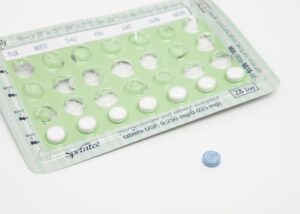March is Women’s History Month, a time to reflect on the progress made in advancing women’s rights while also acknowledging the challenges that persist. One of the most pressing yet under-discussed issues affecting women today is reproductive coercion—a form of abuse that strips individuals of their bodily autonomy and endangers their health and safety.
As we use this month to celebrate the resilience and achievements of women throughout history, it is crucial to also shed light on this pervasive issue, especially given its ties to maternal mortality and domestic violence.
What is Reproductive Coercion?
When we think about domestic violence, we often focus on physical abuse, emotional manipulation, or financial control.
However, another insidious form of abuse is lurking beneath. Reproductive coercion is a form of control where an abuser manipulates or dictates a survivor’s reproductive choices. This form of abuse (like all abuse) is deeply tied to power and control, aiming to strip autonomy from a person’s body, future, and ability to make life-altering decisions on their own terms.
 Reproductive coercion refers to behaviors that interfere with a person’s reproductive autonomy, including:
Reproductive coercion refers to behaviors that interfere with a person’s reproductive autonomy, including:
- Birth control sabotage – An abuser may hide, tamper with, or refuse to allow the use of contraception. “Stealthing” is another form of birth control sabotage commonly seen in younger populations. This act is when a male partner removes a condom (despite previously agreeing to wear one) without the consent of their partner.
- Pregnancy pressure or coercion – Forcing or manipulating a partner into pregnancy or, conversely, coercing them into terminating a pregnancy.
- Control over reproductive healthcare – Preventing access to doctors, forcing specific medical decisions (like sterilization), or refusing to allow the survivor to make independent choices about their body.
- Intentional spread of STDs – Some abusers may contract (either by infidelity or otherwise), then intentionally spread, their sexually transmitted disease. With the stigma surrounding STDs in general, this could be used to keep control over their partner.
This form of control can be incredibly isolating and dangerous. Survivors may feel trapped in a relationship because pregnancy or parenting ties them to their abuser, or they may be denied the ability to make crucial decisions about their own health and future.
Reproductive coercion is rarely an isolated behavior. It often exists alongside other forms of abuse. A partner who engages in reproductive coercion is asserting dominance and control over their victim in the most personal way possible. And, if a woman is experiencing abuse prior to becoming pregnant, research indicates that the abuse can escalate in severity during pregnancy.
Homicide: The Leading Cause of Death in Pregnant Women
Perhaps one of the most chilling statistics related to reproductive coercion and domestic violence is the fact that homicide is the leading cause of death for pregnant women in the United States. A 2022 study published in Obstetrics & Gynecology found that pregnant women are more likely to be killed than to die from medical complications related to pregnancy and childbirth. In many cases, these homicides are committed by intimate partners who escalate violence in response to pregnancy.
 Why does pregnancy increase a person’s risk of homicide? There are several possible factors:
Why does pregnancy increase a person’s risk of homicide? There are several possible factors:
- Pregnancy can increase dependency, making it harder for someone to leave an abusive relationship.
- An abuser may view pregnancy as a loss of control, leading to more extreme violence. Additionally, an abuser may become jealous that they are receiving less attention from their pregnant partner – whether that be sexual attention or otherwise.
- Financial pressures and stressors associated with an impending child can escalate conflict.
These factors make reproductive coercion not only a matter of autonomy but also one of life and death.
The Impact on Maternal Mortality
Reproductive coercion contributes to maternal mortality, particularly among marginalized groups. Black and Indigenous women, who already face disproportionately high maternal mortality rates, are also at higher risk for IPV and reproductive coercion. Lack of access to healthcare, systemic medical racism, and economic disparities further exacerbate the dangers they face.
Women experiencing reproductive coercion may be denied proper prenatal care, discouraged from seeking medical attention, or even physically assaulted during pregnancy. When IPV and reproductive coercion intersect, survivors face an uphill battle in maintaining both their safety and their health.
Recognizing the Signs and Seeking Help
If you or someone you know is experiencing reproductive coercion, it’s crucial to recognize the signs and seek support. Remember, some of the signs of reproductive coercion could be:
- A partner refusing to use condoms or sabotaging birth control.
- Feeling pressured or forced to become pregnant or terminate a pregnancy.
- Having access to reproductive healthcare restricted by a partner.
- Experiencing increased violence or threats after becoming pregnant.
So, what can you do to help stop this abuse from happening?
Be vigilant and informed. Addressing reproductive coercion requires both individual support for survivors and systemic change. Some key areas for improvement include:
- Legislation protecting reproductive rights – Ensuring access to contraception, abortion care, and comprehensive reproductive healthcare that is affordable.
- Medical training for healthcare providers – Educating doctors and nurses to recognize signs of reproductive coercion and safely intervene.
- Increased shelter and advocacy services – Expanding support networks for survivors, particularly pregnant individuals at high risk of IPV.
Reproductive coercion is a profound violation of autonomy and safety. It is deeply intertwined with domestic violence, maternal mortality, and the broader fight for reproductive justice. Recognizing this form of abuse, supporting survivors, and advocating for systemic change are all crucial steps in protecting the health and lives of those at risk.
If you or someone you know needs support, Options Domestic and Sexual Violence Services is here to help. You are not alone, and your choices about your body and future belong to you—not an abuser.
If you need any additional information, have a question, or a concern, feel free to reach out to Options at our 24-hour toll-free helpline 800-794-4624. You can also reach an advocate via text by texting HOPE to 847411 or click 24-Hour Chat with Options.
Written by Anniston Weber
This grant project is supported by the State General Fund for Domestic Violence and Sexual Assault, sub-grant number 24-SGF-07, as administered by the Kansas Governor’s Grants Program. The opinions, findings, conclusions or recommendations expressed in this publication are those of the author(s) and do not necessarily reflect the views of the Office of Kansas Governor.


